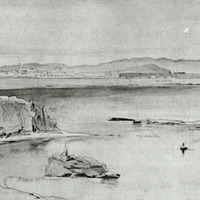Χαλέπα Χανίων
Αντικείμενο
Τίτλος Σημείου Ενδιαφέροντος
el
Χαλέπα Χανίων
en
Chalepa Chania
Περιγραφή / Απόσπασμα
69
en
About half an hour's walk from the gate of Khaniá is the village of Kalépa, situated on a rising ground not far from the shore. From above this village a beautiful view is obtained. On the spectator's left are seen the noble snow-clad Sfakian mountains, and part of the plain of Khaniá, which also lies extended before him. To his right is the fortified city, with its port and shipping; beyond which the eye, passing over the wide gulf of Khaniá, rests on the Dictynnaean promontory, and observes, still further in the distance, the Corycian cape, which terminates the view.
Σύγχρονη περιγραφή
el
Η Χαλέπα είναι ένα σπουδαίο ιστορικό προάστιο, που βρίσκεται ανατολικά από τα Χανιά στον παραλιακό δρόμο προς το αεροδρόμιο. Το όνομα «Χαλέπα» αναφέρεται στο τραχύ έδαφος της περιοχής και ετυμολογείται από το επίθετο της αρχαίας ελληνικής «χαλεπός», που σημαίνει δυσχερής, σκληρός. Η Χαλέπα άρχισε να κατοικείται γύρω στις αρχές του 19ου αιώνα από εύπορους Χανιώτες οι οποίοι έκτισαν πολυτελείς επαύλεις με πλούσιους κήπους και δενδροφυτεμένους δρόμους και την μετεξέλιξαν σε ένα αριστοκρατικό προάστιο, που έδινε την εικόνα ευρωπαϊκού θέρετρου. Εκείνο τον καιρό, τα Χανιά ήταν η πρωτεύουσα της Κρήτης και στη Χαλέπα βρίσκονταν η έδρα του εκάστοτε Γενικού Διοικητή της Κρήτης, οι επαύλεις των γενικών προξένων των Μεγάλων Δυνάμεων καθώς και η Γαλλική Σχολή Καλογραιών, καθιστώντας την έτσι μια πραγματική διεθνή συνοικία. Εδώ πάρθηκαν πολλές σπουδαίες αποφάσεις, που άλλαξαν την ιστορία της Κρήτης και της Νοτιοανατολικής Ευρώπης γενικότερα. Το 1878, στη Χαλέπα συνομολογήθηκε η «Συμφωνία της Χαλέπας», με την οποία εκχωρήθηκε στην Κρήτη η αυτονομία της από την Οθωμανική Αυτοκρατορία και η πόλη των Χανίων θα εξακολουθούσε να αποτελεί την πρωτεύουσα του αυτόνομου κράτους. Στη Χαλέπα βρίσκεται και το σπίτι του σημαντικού Έλληνα πολιτικού, Ελευθερίου Βενιζέλου, το οποίο σήμερα στεγάζει το Εθνικό Ίδρυμα Ερευνών και Μελετών "Ελευθέριος K. Βενιζέλος". Άλλα αξιόλογα κτήρια είναι η παλιά Ελληνική Πρεσβεία, η παλιά Γαλλική Ακαδημία και, φυσικά, ένας ναός ρωσικού ρυθμού, με χαρακτηριστικό τρούλο, η Αγία Μαγδαληνή, που χτίστηκε από τον Πρίγκιπα Γεώργιο τον Α' όταν αυτός ήταν ύπατος αρμοστής Κρήτης, με κεφάλαια που έφερε από τη Ρωσία.
en
Halepa is an important historical suburb, which is east of Hania at the seaside road towards the airport. The name “Halepa” refers to the rough terrain of the area and it comes from the ancient Greek adjective “halepos” which means difficult, rough. Halepa started having residents at the beginning of the 19th century, rich people from Hania, who built luxurious mansions with rich gardens and roads with planted trees and made it into an aristocratic suburb, which looked as if it was a European resort. During that period, Hania was the capital of Crete and Halepa was the seat of the General Commander of Crete. Halepa was also where the mansions of the general consulates of the Great Forces were, as well as the French School of Nuns, making it thus a true international neighborhood. There, many important decisions were taken, decisions that changed the history of Crete and Southeastern Europe in general. In 1878, in Halepa, the “Agreement of Halepa” was concluded, with which Crete got her independence from the Ottoman Empire and the city of Hania would continue being the capital of the autonomous state. The house of the great Greek politician Eleftherios Venizelos is also in Halepa, which today houses the National Institution of Research and Studies “Eleftherios K. Venizelos”. Other remarkable buildings are the old Greek Consulate, the old French Academy, and, of course, a temple of Russian style, with a characteristic dome, Saint Magdalene, which was built by Prince George the 1st, when he was High Commissioner of Crete, with capitals brought from Russia.




